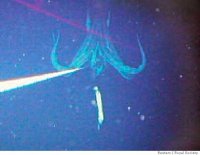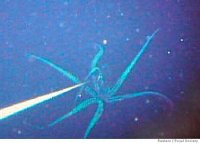Littledragon
Above The Law
For decades, scientists and sea explorers have mounted costly expeditions to hunt down and photograph the giant squid, a legendary monster with eyes the size of dinner plates and a nightmarish tangle of tentacles lined with long rows of sucker pads.
The goal has been to learn more about a bizarre creature of no little fame -- Jules Verne's attacked a submarine, and Peter Benchley's ate children -- that in real life has stubbornly refused to give up its secrets.
While giant squid have been snagged in fishing nets, and dead or dying ones have washed ashore, expeditions have repeatedly failed to photograph a live one in its natural habitat, the inky depths of the sea. But two Japanese scientists, Tsunemi Kubodera and Kyoichi Mori, report today in a leading British biological journal that they have made the world's first observations of a giant squid in the wild.
Working about 600 miles south of Tokyo off the Bonin Islands, known in Japan as the Ogasawara Islands, they managed to photograph the creature with a robotic camera at a depth of 3,000 feet. During a struggle lasting more than four hours, the 26-foot-long animal took the proffered bait and eventually broke free, leaving behind an 18-foot length of tentacle.
The giant squid, the researchers conclude, "appears to be a much more active predator than previously suspected, using its elongate feeding tentacles to strike and tangle prey." They report that the tentacles could apparently coil into a ball, much as a python envelops its victims.
The Japanese researchers are reporting their find today in the Proceedings of the Royal Society B (the B standing for the biological sciences). The London group is the world's oldest scientific organization.
Scientists praised the discovery as a long-awaited breakthrough.
"This has been a mystery for a thousand years," said Richard Ellis, author of "Monsters of the Sea."
"Nobody knew what they looked like in the wild," Ellis said. "We only saw them dead. These images will open the door to more detailed study of their life."
Squid hunters themselves are agog, and some perhaps a bit jealous.
"Wow!" said Emory Kristof, a photographer for National Geographic who twice ventured to New Zealand in hopes of capturing giant squid on film. "It's always been presumptuous to say you're hunting the giant squid when we know so little. It's great that they got it."
The Japanese researchers work for the National Science Museum in Tokyo and the Ogasawara Whale-Watching Association. They discovered the giant by following packs of sperm whales, which are known to feed on the giant squid. With squid remains being found near the Bonin Islands, the researchers focused their hunt there.
They created a float system with a long line from which they suspended a robotic camera and strobe light. The camera looked downward at hooks baited with small squid and took pictures every 30 seconds. A bag of mashed shrimp acted as an odor lure. The researchers set up a number of such rigs near the islands.
On Sept. 30 of last year, a squid attacked the lowest bait on a rig that was positioned about 1,000 feet above the sea floor. Giant squid have eight short arms and two long tentacles. During the attack, the squid wrapped its two long tentacles like a ball around the bait, the researchers report.
One tentacle was caught, and the creature moved violently for four hours to break free. It was often out of camera range, suggesting, the scientists say, that it was trying to swim free.
After 4 hours and 13 minutes of struggle, the animal tore away, leaving the tentacle behind. Once on the surface "the recovered section of tentacle was still functioning," they continued, "with the large suckers of the tentacle club repeatedly gripping the boat deck and any offered fingers."
At an estimated size of 26 feet, this is a relatively small specimen; giant squid are thought to grow as long as 60 feet. But with DNA analysis and other comparisons with squid that have washed ashore, the researchers confirmed that it was a giant.
The squid is often known by its genus name, Architeuthis (pronounced ark-uh-TOOTH-iss), Greek for chief squid. The researchers say their photos dispel the notion that it is a sluggish creature that trolls for prey.
"The long tentacles are clearly not weak fishing lines dangled below the body," they write. "Our images suggest that giant squids are much more active predators than previously suggested."
The first complete specimen of a giant squid, captured dead by fishermen off Newfoundland, was found in 1874. Subsequent remains, either washed up on beaches or trapped in nets, have appeared occasionally in high latitudes -- Canadian and Japanese waters, or off Tasmania and elsewhere in Australia.
The Washington Post contributed to this report.
The goal has been to learn more about a bizarre creature of no little fame -- Jules Verne's attacked a submarine, and Peter Benchley's ate children -- that in real life has stubbornly refused to give up its secrets.
While giant squid have been snagged in fishing nets, and dead or dying ones have washed ashore, expeditions have repeatedly failed to photograph a live one in its natural habitat, the inky depths of the sea. But two Japanese scientists, Tsunemi Kubodera and Kyoichi Mori, report today in a leading British biological journal that they have made the world's first observations of a giant squid in the wild.
Working about 600 miles south of Tokyo off the Bonin Islands, known in Japan as the Ogasawara Islands, they managed to photograph the creature with a robotic camera at a depth of 3,000 feet. During a struggle lasting more than four hours, the 26-foot-long animal took the proffered bait and eventually broke free, leaving behind an 18-foot length of tentacle.
The giant squid, the researchers conclude, "appears to be a much more active predator than previously suspected, using its elongate feeding tentacles to strike and tangle prey." They report that the tentacles could apparently coil into a ball, much as a python envelops its victims.
The Japanese researchers are reporting their find today in the Proceedings of the Royal Society B (the B standing for the biological sciences). The London group is the world's oldest scientific organization.
Scientists praised the discovery as a long-awaited breakthrough.
"This has been a mystery for a thousand years," said Richard Ellis, author of "Monsters of the Sea."
"Nobody knew what they looked like in the wild," Ellis said. "We only saw them dead. These images will open the door to more detailed study of their life."
Squid hunters themselves are agog, and some perhaps a bit jealous.
"Wow!" said Emory Kristof, a photographer for National Geographic who twice ventured to New Zealand in hopes of capturing giant squid on film. "It's always been presumptuous to say you're hunting the giant squid when we know so little. It's great that they got it."
The Japanese researchers work for the National Science Museum in Tokyo and the Ogasawara Whale-Watching Association. They discovered the giant by following packs of sperm whales, which are known to feed on the giant squid. With squid remains being found near the Bonin Islands, the researchers focused their hunt there.
They created a float system with a long line from which they suspended a robotic camera and strobe light. The camera looked downward at hooks baited with small squid and took pictures every 30 seconds. A bag of mashed shrimp acted as an odor lure. The researchers set up a number of such rigs near the islands.
On Sept. 30 of last year, a squid attacked the lowest bait on a rig that was positioned about 1,000 feet above the sea floor. Giant squid have eight short arms and two long tentacles. During the attack, the squid wrapped its two long tentacles like a ball around the bait, the researchers report.
One tentacle was caught, and the creature moved violently for four hours to break free. It was often out of camera range, suggesting, the scientists say, that it was trying to swim free.
After 4 hours and 13 minutes of struggle, the animal tore away, leaving the tentacle behind. Once on the surface "the recovered section of tentacle was still functioning," they continued, "with the large suckers of the tentacle club repeatedly gripping the boat deck and any offered fingers."
At an estimated size of 26 feet, this is a relatively small specimen; giant squid are thought to grow as long as 60 feet. But with DNA analysis and other comparisons with squid that have washed ashore, the researchers confirmed that it was a giant.
The squid is often known by its genus name, Architeuthis (pronounced ark-uh-TOOTH-iss), Greek for chief squid. The researchers say their photos dispel the notion that it is a sluggish creature that trolls for prey.
"The long tentacles are clearly not weak fishing lines dangled below the body," they write. "Our images suggest that giant squids are much more active predators than previously suggested."
The first complete specimen of a giant squid, captured dead by fishermen off Newfoundland, was found in 1874. Subsequent remains, either washed up on beaches or trapped in nets, have appeared occasionally in high latitudes -- Canadian and Japanese waters, or off Tasmania and elsewhere in Australia.
The Washington Post contributed to this report.




